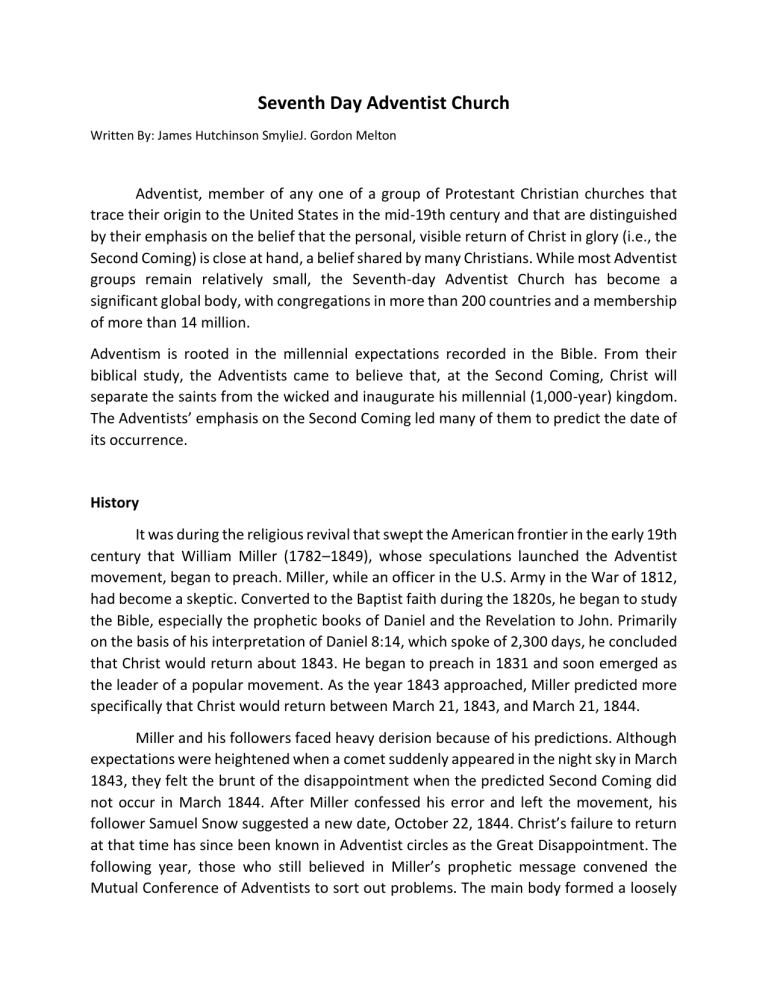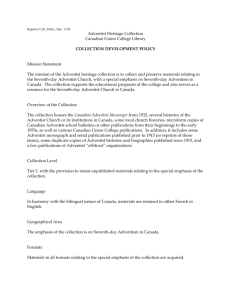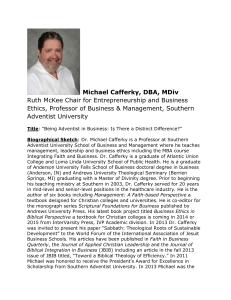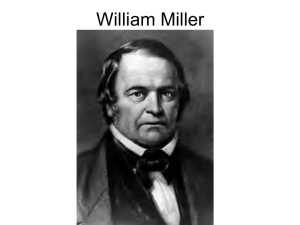
Seventh Day Adventist Church Written By: James Hutchinson SmylieJ. Gordon Melton Adventist, member of any one of a group of Protestant Christian churches that trace their origin to the United States in the mid-19th century and that are distinguished by their emphasis on the belief that the personal, visible return of Christ in glory (i.e., the Second Coming) is close at hand, a belief shared by many Christians. While most Adventist groups remain relatively small, the Seventh-day Adventist Church has become a significant global body, with congregations in more than 200 countries and a membership of more than 14 million. Adventism is rooted in the millennial expectations recorded in the Bible. From their biblical study, the Adventists came to believe that, at the Second Coming, Christ will separate the saints from the wicked and inaugurate his millennial (1,000-year) kingdom. The Adventists’ emphasis on the Second Coming led many of them to predict the date of its occurrence. History It was during the religious revival that swept the American frontier in the early 19th century that William Miller (1782–1849), whose speculations launched the Adventist movement, began to preach. Miller, while an officer in the U.S. Army in the War of 1812, had become a skeptic. Converted to the Baptist faith during the 1820s, he began to study the Bible, especially the prophetic books of Daniel and the Revelation to John. Primarily on the basis of his interpretation of Daniel 8:14, which spoke of 2,300 days, he concluded that Christ would return about 1843. He began to preach in 1831 and soon emerged as the leader of a popular movement. As the year 1843 approached, Miller predicted more specifically that Christ would return between March 21, 1843, and March 21, 1844. Miller and his followers faced heavy derision because of his predictions. Although expectations were heightened when a comet suddenly appeared in the night sky in March 1843, they felt the brunt of the disappointment when the predicted Second Coming did not occur in March 1844. After Miller confessed his error and left the movement, his follower Samuel Snow suggested a new date, October 22, 1844. Christ’s failure to return at that time has since been known in Adventist circles as the Great Disappointment. The following year, those who still believed in Miller’s prophetic message convened the Mutual Conference of Adventists to sort out problems. The main body formed a loosely knit fellowship, the Evangelical Adventists, which became the foundation of all modern Adventist churches. Caricature (1843) of a Millerite, an adherent of the preacher William Miller, who predicted that the world would end between March 21, 1843, and March 21, 1844. The man sits in a large safe labeled “Patent Fire Proof Chest.” Library of Congress, Washington, D.C. (digital file no. 3a24747u) Among those who continued to accept Miller’s prophecy were Joseph Bates, James White, and White’s wife, Ellen Harmon White. They believed that Miller had set the right date but had interpreted events incorrectly. From their reading of Daniel, chapters 8 and 9, they concluded that God had begun the “cleansing of the heavenly sanctuary”—i.e., an investigative judgment (an action invisible to the human eye) that would then be followed by the pronouncing and execution of the sentence of judgment (a future visible event). In 1844, in their view, God had begun an examination of all the names in the Book of Life, and only after this was completed would Christ appear and begin his millennial reign. They refrained from setting a new date for that visible appearance, but they insisted that Christ’s advent was imminent. They also came to believe that worship on the seventh day, Saturday, was proper for Christians. The practice of Saturday worship gave the denomination (established in 1863) a new name, the Seventh-day Adventist Church. The Seventh-day Adventists also believed that Ellen White had the gift of prophecy, and her lectures and writings shaped the later beliefs and practices of the church. Other Adventist bodies emerged in the 19th century. Some, such as the Advent Christian Church and the Life and Advent Union (which merged into the Advent Christian Church in 1964), rejected both the prophetic status of Ellen White and seventh-day worship. Another group, the International Bible Students Association, inspired by Miller and Adventist teachings, was founded by the preacher Charles Taze Russell in 1872. Changing its name to the Jehovah’s Witnesses in the 1930s, it became the second successful group to emerge from the original Millerite movement. Another Sabbatarian church, the Worldwide Church of God, emerged in the 1930s; at its height in the 1980s, it claimed more than 100,000 members. During the 1990s the Worldwide Church of God engaged in a process of doctrinal reevaluation that led it to renounce the beliefs it had inherited from Adventism and join the larger Evangelical movement. Belief in Sabbath observance brought with it a new appreciation of the Hebrew Bible (the Old Testament). The Seventh-day Adventists accepted Old Testament dietary regulations, from which their present-day emphasis on health developed. In 1900 two members of the church, John Harvey Kellogg and his brother W.K. Kellogg, founded the Sanitas Food Company, later called the Kellogg Company, to market a healthy breakfast cereal that had been served at a church sanatorium run by John Harvey Kellogg. (The sanatorium’s many prominent patients included C.W. Post, later the founder of the Postum Cereal Company.) The church’s emphasis on healthy living and preventive medicine was augmented by the founding in 1908 of a chain of outstanding medical institutions. The church became a pioneer of medical missions, establishing hundreds of hospitals, medical centres, clinics, and sanatoriums across the United States and throughout the world. John Harvey Kellogg, undated photograph. George Grantham Bain Collection/Library of Congress, Washington, D.C. (digital file no. 15047u) Beliefs and Practices Seventh-day Adventists share many of the basic beliefs of Protestant Christianity, including acceptance of the authority of the Bible, recognition of the existence of human sin and the need for salvation, and belief in the atoning work of Christ. They are officially Trinitarian, believing in the three coeternal persons of the Godhead, but on several occasions they have seriously debated this doctrine, and some Adventist groups have rejected it. Seventh-day Adventism emerged at a time when many Protestants were divided into Calvinist and Arminian camps, the former emphasizing predestination and the sovereignty of God, the latter human choice and God’s election. The Adventists came to accept the Arminian interpretation of Christ’s atonement. They argue that his death was “provisionally and potentially for all men” yet efficacious only for those who avail themselves of its benefits. In addition to the emphasis upon the Second Advent of Christ, two other matters set the Adventists apart from most Christians. First, they observe Saturday, rather than Sunday, as the Sabbath. This day, according to the Bible, was instituted by God, and the commandment concerning Sabbath rest is a part of God’s eternal law. Second, they also avoid eating meat and taking narcotics and stimulants, which they consider to be harmful. Although they appeal to the Bible for the justification of these dietary practices, they maintain that these are primarily based upon the broad theological consideration that the body is the temple of the Holy Spirit and should be protected. Adventists stress tithing and therefore have a high annual giving per capita that allows them to carry on worldwide missionary and welfare programs. Because of their unwillingness to work on Saturday, they periodically suffer job discrimination. In the United States they joined forces with the Jewish community to promote laws accommodating Sabbatarian practice. Institutions The nearness of the Second Coming motivated Adventists to engage in worldwide missionary work. Seventh-day Adventism sent out its first missionary, John Nevins Andrews, in 1874 and eventually expanded into a worldwide movement, with churches in nearly every country where it was legally permitted by the early 21st century. The emphasis on missionary activity won the church many new adherents in Latin America, the Caribbean, and sub-Saharan Africa. The General Conference, the church’s main governing body, has its headquarters in Silver Spring, Maryland, where it was moved in 1989 from Washington, D.C. The General Conference meets quadrennially. Local congregations in a particular area or country are associated in conferences, and each conference is in turn a member of one of the 14 regional divisions into which the world church is organized. The General Conference supervises evangelical work in more than 500 languages. It also manages a large parochial school system and a set of orphanages and retirement homes. Adventist publishing houses operate in many countries, and Adventist literature is distributed door-to-door by volunteers. Group 4 Members: 1. Franchette Faye Limetares 2. Winston Lagumbay 3. Kris Ann Conejero 4. Sarame Penaso 5. Marie Faye Generalao 6. Marjerie Ongayo 7. Reyle Dinopol 8. Princess Jaye Rallos 9. Kimberly Villagantol 10. Angelie Pujanes 11. Trecia Mae Razonado





